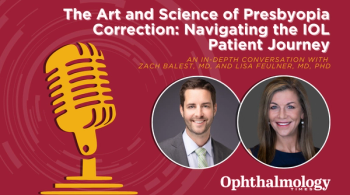
Study: Dexamethasone intraocular suspension 9% offering high surgeon, patient satisfaction after cataract surgery
Cathleen McCabe, MD, presents results of a retrospective study highlighting the effectiveness of dexamethasone intraocular suspension 9% following cataract surgery.
Reviewed by Cathleen M. McCabe, MD
Dexamethasone intraocular suspension 9% (Dexycu, EyePoint Pharmaceuticals) offered a high level of surgeon and patient satisfaction in a retrospective study of the drug’s performance, according to Cathleen M. McCabe, MD, who presented results of the study during the American Society of Cataract and Refractive Surgery 2021 annual meeting in Las Vegas.
McCabe, of The Eye Associates, Bradenton, Florida, was an investigator in a retrospective study of the drug’s efficacy and safety, which was also designed to collect data on surgeons’ real-world impressions of efficacy, ease of use, and patient satisfaction.
Data were collected from patient records at multiple US surgical sites between March 12 and December 15, 2019.
The surgeons reported their satisfaction was based on their individual patient’s experience and rated the patient satisfaction based on their impressions. The surgeons also rated the drug’s efficacy compared with topical steroids.
Results
Data from 527 patients (641 eyes; mean age, 71.5 years) were included in the study.
The data analysis showed that the dexamethasone intraocular suspension scored high marks compared with use of topical steroids, with 92.3% of surgeons stating they were satisfied or very satisfied with the drug’s performance and 83.8% did the same when asked about the drug’s ease of use.
The surgeons reported overall patient satisfaction of 80.6% based on their impressions of the drug.
When the surgeons were asked to rank the efficacy of the intraocular suspension compared with that of topical steroids, 70.3% reported comparable efficacy and 27.9% superior efficacy.
It is worth noting that the data were collected based on the early clinical experience with the drug before the technique of capsular bag administration was developed and before vortex mixers ensured the uniformity of the drug suspension, McCabe explained.
“At the end of the surgery, instilling the drug in the capsular bag enables surgeons to see the volume of the drug and that visibility increases the likelihood that the drop will remain in the desired place,” she said.
To ensure the best results with the intraocular suspension, the eye should have a deep and stable chamber and well-sealed incisions.
In addition, the eye should be pressurized to the physiologic pressure or slightly above.
When the drug has been instilled, McCabe advises minimizing any manipulations and a gentle rehydration of the eye, if needed.
“The data from this retrospective study indicate that surgeons and patients had favorable early impressions of the dexamethasone intraocular suspension 9% in cataract surgery,” McCabe concluded. “Refinements to the administration technique should further improve the satisfaction and ease of use.”
--
Cathleen M. McCabe, MD
E:
This article is adapted from McCabe’s presentation at the American Society of Cataract and Refractive Surgery. She is a consultant to and speaker for EyePoint Pharmaceuticals, Inc.
Newsletter
Don’t miss out—get Ophthalmology Times updates on the latest clinical advancements and expert interviews, straight to your inbox.













































.png)


